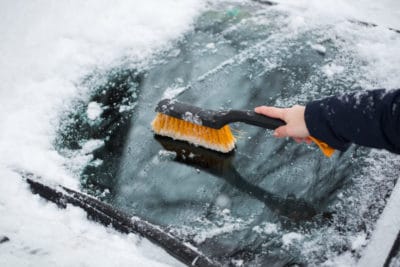December 17, 2019

Winter storms and cold temperatures can be dangerous. Stay safe and healthy by planning ahead. Prepare your home and cars. Prepare for power outages and outdoor activity. Check on older adults.
Although winter comes as no surprise, many of us are not ready for its arrival. If you are prepared for the hazards of winter, you will be more likely to stay safe and healthy when temperatures start to fall.
Take These Steps for Your Home
Many people prefer to remain indoors during winter, but staying inside is no guarantee of safety. Take these steps to keep your home safe and warm during the winter months.
- Winterize your home.
- Install weather stripping, insulation, and storm windows.
- Insulate water lines that run along exterior walls.
- Clean out gutters and repair roof leaks.
- Check your heating systems.
- Have your heating system serviced professionally to make sure it is clean, working properly, and ventilated to the outside.
- Inspect and clean fireplaces and chimneys.
- Install a smoke detector. Test batteries monthly and replace them twice a year.
- Identify a safe alternate heating source. Keep alternate fuels on-hand and stored safely.
- Prevent carbon monoxide (CO) emergencies.
- Install a CO detector to alert you to the presence of this deadly, odorless, colorless gas. Check batteries when you change your clocks in fall and spring.
- Learn the symptoms of CO poisoning: headache, dizziness, weakness, upset stomach, vomiting, chest pain, and confusion.
Don’t Forget to Prepare Your Car
Get your car ready for cold weather use before winter arrives.
- Service the radiator and maintain the antifreeze level.
- Check the tread on your tires or, if necessary, replace tires with all-weather or snow tires.
- Keep your gas tank full to avoid ice in the tank and fuel lines.
- Use a winter-time formula in your windshield washer.
- Prepare a winter emergency kit to keep in your car in case you become stranded. The kit should include the following
- cell phone, portable charger, and extra batteries;
- blankets;
- water and nonperishable food;
- booster cables, flares, tire pump, and a bag of sand or cat litter (for traction);
- compass and maps;
- flashlight, battery-powered radio, and extra batteries;
- first-aid kit; and
- plastic bags (for waste).
Equip in Advance for Emergencies
Be prepared for weather-related emergencies, including power outages.
- Stock food that needs no cooking or refrigeration and water stored in clean containers.
- Ensure that your cell phone is fully charged.
- When planning travel, be aware of current and forecast weather conditions.
- Keep an up-to-date emergency kit, including the following
- Battery-operated devices, such as a flashlight, a National Oceanic and Atmospheric Administration (NOAA) Weather Radio, and lamps;
- extra batteries;
- first-aid kit and extra medicine;
- baby items; and
- cat litter or sand for icy walkways.
- Protect your family from carbon monoxide (CO).
- Keep grills, camp stoves, and generators out of the house, basement, and garage.
- Locate generators at least 20 feet from any window, door, or vent and in a space where rain and snow will not reach them.
- Leave your home immediately if the CO detector sounds and call 911.
Extreme Cold Preparedness for Children
Adapted from American Academy of Pediatrics Website
Because children are less able to regulate their body temperature than adults, exposure to extreme cold can quickly lead to dangerously low body temperatures (i.e., hypothermia). Newborn infants are prone to hypothermia because of their large body surface area, small amount of subcutaneous fat, and decreased ability to shiver. Children and adults respond to cold extremes by shivering, developing “goose bumps,” and experiencing lethargy and a slow heart rate. Eventually, the shivering ends, and disorientation and lack of responsiveness occur. Severe hypothermia can also result in an abnormal beating of the heart (i.e., arrhythmia).
The following steps can help to protect your body from cold extremes and their consequences:
- Wear proper cold-weather gear.
- Avoid severe cold.
- Find alternate shelter if the home or residence has lost its heat.
- Use safe indoor heating sources.
- Ensure that all stoves and fireplaces are adequately vented
- Do not use charcoal indoors.
- Do not use gasoline or diesel generators indoors or outside near an open window or vent that could bring in fumes.
- Locate generators at least 20 feet from any window, door, or vent and in a space where rain and snow will not reach them.
